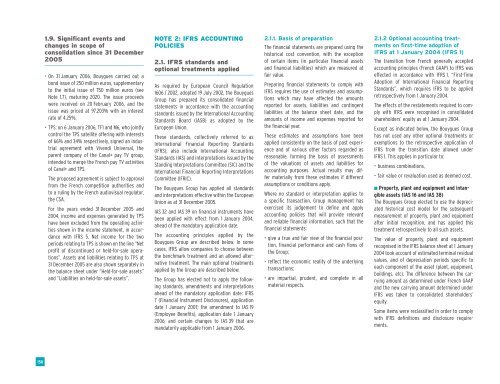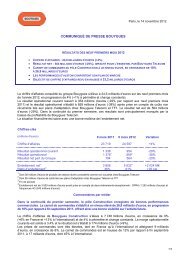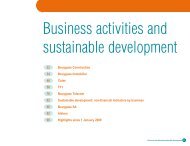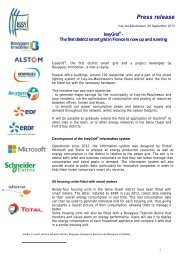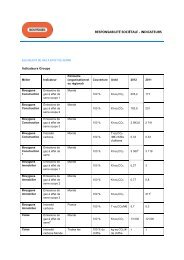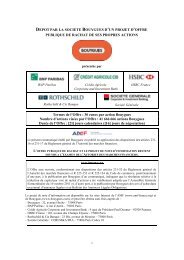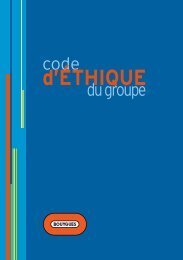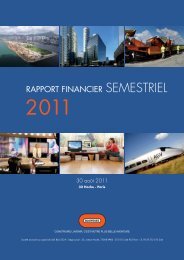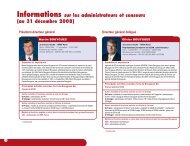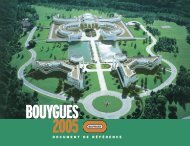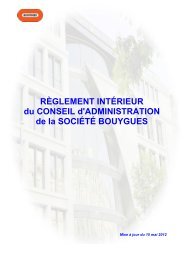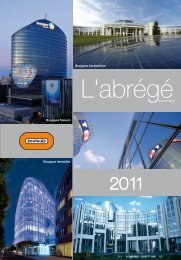A N N U A L R E P O R T - Bouygues
A N N U A L R E P O R T - Bouygues
A N N U A L R E P O R T - Bouygues
Create successful ePaper yourself
Turn your PDF publications into a flip-book with our unique Google optimized e-Paper software.
1.9. Significant events and<br />
changes in scope of<br />
consolidation since 31 December<br />
2005<br />
• On 31 January 2006, <strong>Bouygues</strong> carried out a<br />
bond issue of 250 million euros, supplementary<br />
to the initial issue of 750 million euros (see<br />
Note 1.7), maturing 2020. The issue proceeds<br />
were received on 20 February 2006, and the<br />
issue was priced at 97.203% with an interest<br />
rate of 4.25%.<br />
• TPS: on 6 January 2006, TF1 and M6, who jointly<br />
control the TPS satellite offering with interests<br />
of 66% and 34% respectively, signed an industrial<br />
agreement with Vivendi Universal, the<br />
parent company of the Canal+ pay TV group,<br />
intended to merge the French pay TV activities<br />
of Canal+ and TPS.<br />
The proposed agreement is subject to approval<br />
from the French competition authorities and<br />
to a ruling by the French audiovisual regulator,<br />
the CSA.<br />
For the years ended 31 December 2005 and<br />
2004, income and expenses generated by TPS<br />
have been excluded from the operating activities<br />
shown in the income statement, in accordance<br />
with IFRS 5. Net income for the two<br />
periods relating to TPS is shown on the line “Net<br />
profit of discontinued or held-for-sale operations”.<br />
Assets and liabilities relating to TPS at<br />
31 December 2005 are also shown separately in<br />
the balance sheet under “Held-for-sale assets”<br />
and “Liabilities on held-for-sale assets”.<br />
NOTE 2: IFRS ACCOUNTING<br />
POLICIES<br />
2.1. IFRS standards and<br />
optional treatments applied<br />
As required by European Council Regulation<br />
1606 / 2002, adopted 19 July 2002, the <strong>Bouygues</strong><br />
Group has prepared its consolidated financial<br />
statements in accordance with the accounting<br />
standards issued by the International Accounting<br />
Standards Board (IASB) as adopted by the<br />
European Union.<br />
These standards, collectively referred to as<br />
International Financial Reporting Standards<br />
(IFRS), also include International Accounting<br />
Standards (IAS) and interpretations issued by the<br />
Standing Interpretations Committee (SIC) and the<br />
International Financial Reporting Interpretations<br />
Committee (IFRIC).<br />
The <strong>Bouygues</strong> Group has applied all standards<br />
and interpretations effective within the European<br />
Union as at 31 December 2005.<br />
IAS 32 and IAS 39 on financial instruments have<br />
been applied with effect from 1 January 2004,<br />
ahead of the mandatory application date.<br />
The accounting principles applied by the<br />
<strong>Bouygues</strong> Group are described below. In some<br />
cases, IFRS allow companies to choose between<br />
the benchmark treatment and an allowed alternative<br />
treatment. The main optional treatments<br />
applied by the Group are described below.<br />
The Group has elected not to apply the following<br />
standards, amendments and interpretations<br />
ahead of the mandatory application date: IFRS<br />
7 (Financial Instrument Disclosures), application<br />
date 1 January 2007; the amendment to IAS 19<br />
(Employee Benefits), application date 1 January<br />
2006; and certain changes to IAS 39 that are<br />
mandatorily applicable from 1 January 2006.<br />
2.1.1. Basis of preparation<br />
The financial statements are prepared using the<br />
historical cost convention, with the exception<br />
of certain items (in particular financial assets<br />
and financial liabilities) which are measured at<br />
fair value.<br />
Preparing financial statements to comply with<br />
IFRS requires the use of estimates and assumptions<br />
which may have affected the amounts<br />
reported for assets, liabilities and contingent<br />
liabilities at the balance sheet date, and the<br />
amounts of income and expenses reported for<br />
the financial year.<br />
These estimates and assumptions have been<br />
applied consistently on the basis of past experience<br />
and of various other factors regarded as<br />
reasonable, forming the basis of assessments<br />
of the valuations of assets and liabilities for<br />
accounting purposes. Actual results may differ<br />
materially from these estimates if different<br />
assumptions or conditions apply.<br />
Where no standard or interpretation applies to<br />
a specific transaction, Group management has<br />
exercised its judgement to define and apply<br />
accounting policies that will provide relevant<br />
and reliable financial information, such that the<br />
financial statements:<br />
• give a true and fair view of the financial position,<br />
financial performance and cash flows of<br />
the Group;<br />
• reflect the economic reality of the underlying<br />
transactions;<br />
• are impartial, prudent, and complete in all<br />
material respects.<br />
2.1.2 Optional accounting treatments<br />
on first-time adoption of<br />
IFRS at 1 January 2004 (IFRS 1)<br />
The transition from French generally accepted<br />
accounting principles (French GAAP) to IFRS was<br />
effected in accordance with IFRS 1, “First-Time<br />
Adoption of International Financial Reporting<br />
Standards”, which requires IFRS to be applied<br />
retrospectively from 1 January 2004.<br />
The effects of the restatements required to comply<br />
with IFRS were recognised in consolidated<br />
shareholders’ equity as at 1 January 2004.<br />
Except as indicated below, the <strong>Bouygues</strong> Group<br />
has not used any other optional treatments or<br />
exemptions to the retrospective application of<br />
IFRS from the transition date allowed under<br />
IFRS 1. This applies in particular to:<br />
• business combinations,<br />
• fair value or revaluation used as deemed cost.<br />
■ Property, plant and equipment and intangible<br />
assets (IAS 16 and IAS 38)<br />
The <strong>Bouygues</strong> Group elected to use the depreciated<br />
historical cost model for the subsequent<br />
measurement of property, plant and equipment<br />
after initial recognition, and has applied this<br />
treatment retrospectively to all such assets.<br />
The value of property, plant and equipment<br />
recognised in the IFRS balance sheet at 1 January<br />
2004 took account of estimated terminal residual<br />
values, and of depreciation periods specific to<br />
each component of the asset (plant, equipment,<br />
buildings, etc). The difference between the carrying<br />
amount as determined under French GAAP<br />
and the new carrying amount determined under<br />
IFRS was taken to consolidated shareholders’<br />
equity.<br />
Some items were reclassified in order to comply<br />
with IFRS definitions and disclosure requirements.<br />
158


